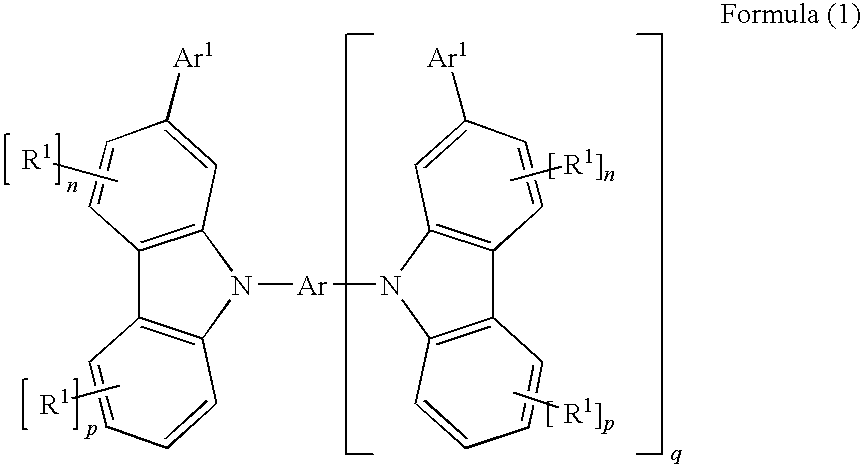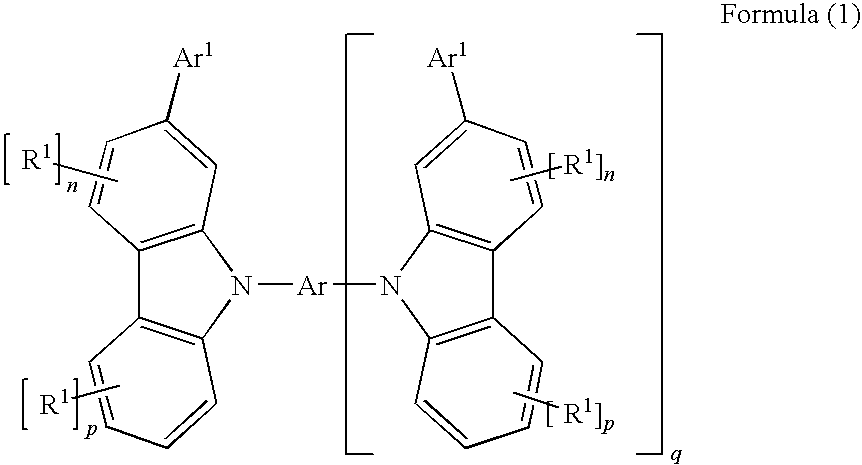Carbazole derivatives for organic electroluminescent devices
a technology of organic electroluminescent devices and derivatives, which is applied in the direction of triarylamine dye, sustainable manufacturing/processing, and final product manufacturing, etc., can solve the problems of low power efficiency, short operating life, and oleds which exhibit triplet emission, so as to improve the efficiency of the device, increase the glass-transition temperature, and prolong the life
- Summary
- Abstract
- Description
- Claims
- Application Information
AI Technical Summary
Benefits of technology
Problems solved by technology
Method used
Image
Examples
example 1
General Synthetic Procedure for the Carbazole Synthesis
[0088]
[0089]A mixture of 238 mmol of the corresponding nitroaromatic compound and 290.3 ml (1669 mmol) of triethyl phosphite is heated under reflux for 12 h. The remaining triethyl phosphite is subsequently distilled off (72-76° C. / 9 mmHg). Water / MeOH (1:1) is added to the residue, and the solid is filtered off and recrystallised.
example 2
General Synthetic Procedure for the Hartwig-Buchwald Coupling
[0090]
[0091]A degassed solution of 176 mmol of the carbazole derivative and 64.2 mmol of the dibromoaromatic compound in 250 ml of xylene is saturated with N2 for 1 h. Firstly 3 ml (12.2 mmol) of P(tBu)3, then 0.5 g (2.45 mmol) of palladium acetate are then added to the solution, and 81.9 g (956 mmol) of K3PO4 in the solid state are subsequently added. The reaction mixture is heated under reflux for 18 h. After cooling to room temperature, 1000 ml of water are carefully added. The organic phase is washed with 4×50 ml of H2O and dried over MgSO4, and the solvents are removed in vacuo. The pure product is obtained by recrystallisation.
example 3
Synthesis of bis[2-phenylcarbazolyl]biphenyl (C1)
[0092]a) Synthesis of 2-phenyl-9H-carbazole
[0093]
[0094]The synthesis of this compound is described in the literature (M. Tavasli et al., Synthesis 2005, 1619-1624).
[0095]b) Reaction with 4,4′-dibromobiphenyl to Give bis[2-phenyl-carbazolyl]biphenyl
[0096]
[0097]The synthesis is carried out by the general synthetic procedure according to Example 2 using 4,4′-dibromobiphenyl. The solid obtained is washed by stirring with hot dioxane, then with MeOH and subsequently with ethyl acetate; yield: 39 g, 96% of theory; purity: 99.9% according to HPLC.
PUM
| Property | Measurement | Unit |
|---|---|---|
| atomic number | aaaaa | aaaaa |
| atomic number | aaaaa | aaaaa |
| atomic number | aaaaa | aaaaa |
Abstract
Description
Claims
Application Information
 Login to View More
Login to View More - R&D
- Intellectual Property
- Life Sciences
- Materials
- Tech Scout
- Unparalleled Data Quality
- Higher Quality Content
- 60% Fewer Hallucinations
Browse by: Latest US Patents, China's latest patents, Technical Efficacy Thesaurus, Application Domain, Technology Topic, Popular Technical Reports.
© 2025 PatSnap. All rights reserved.Legal|Privacy policy|Modern Slavery Act Transparency Statement|Sitemap|About US| Contact US: help@patsnap.com



